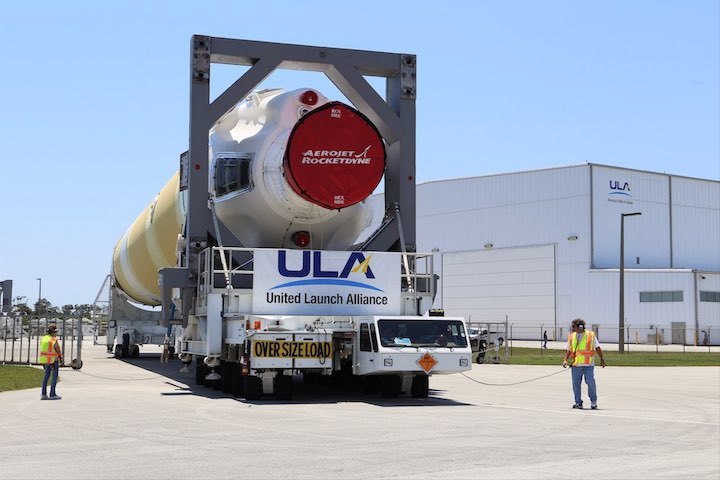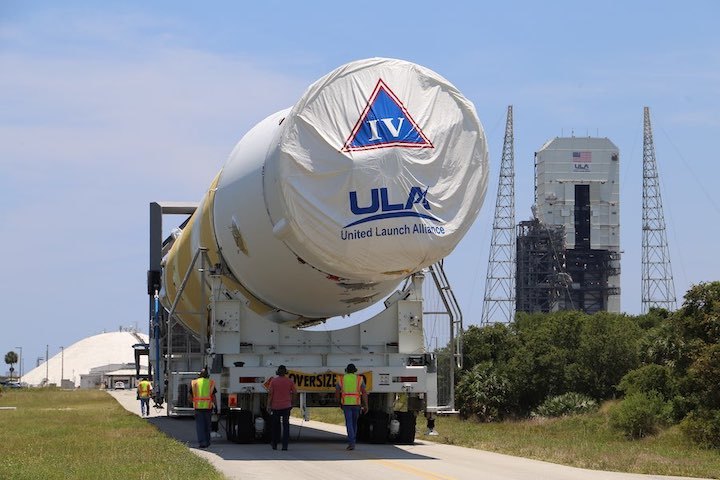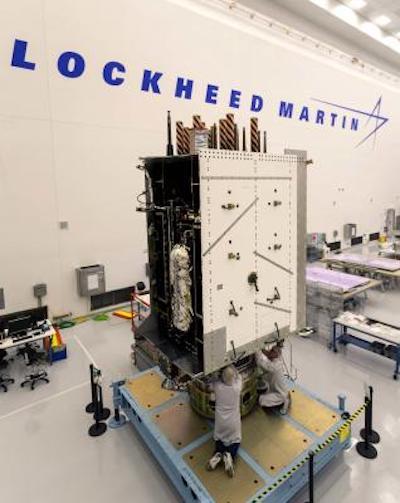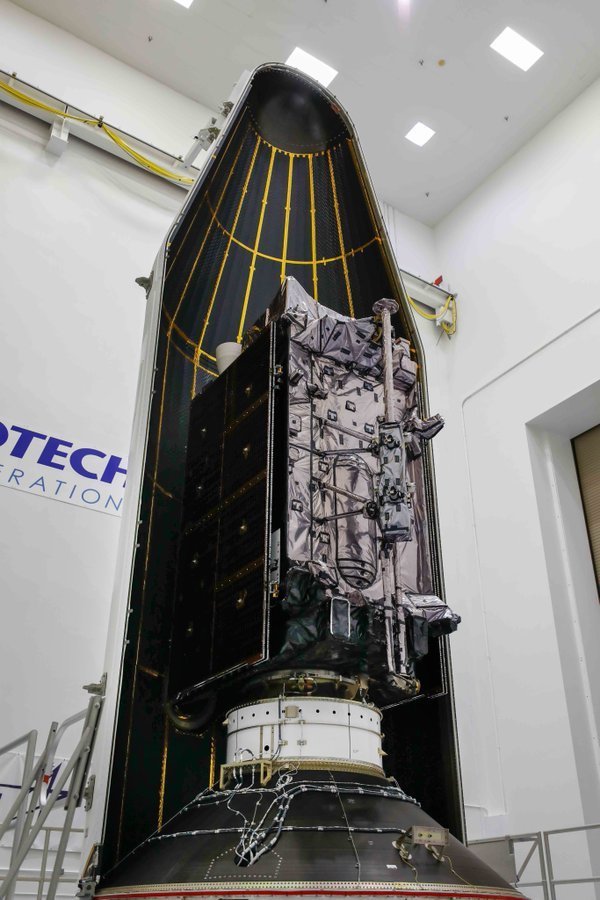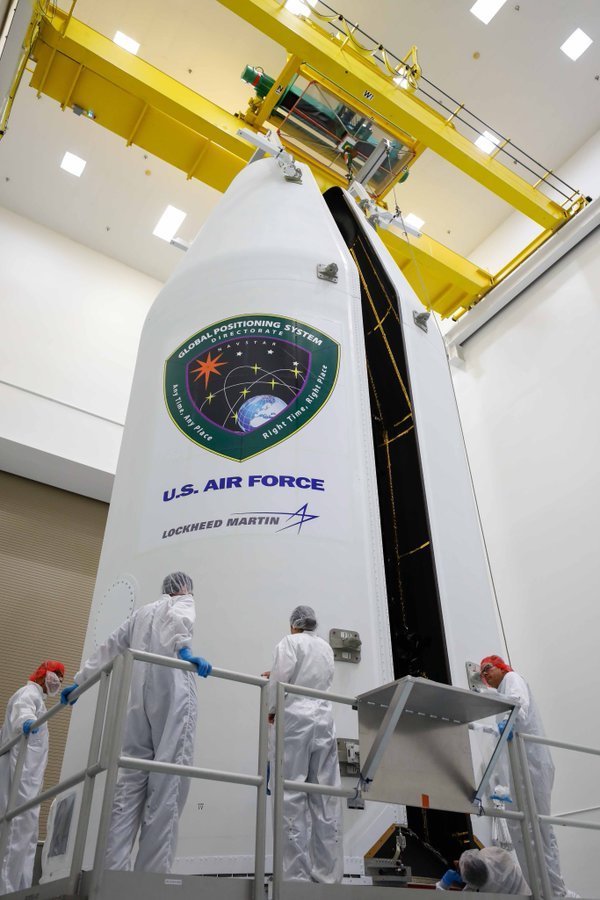23.03.2019
GPS III Space Vehicle 02 “Magellan” arrives in Florida; Prepares for July launch
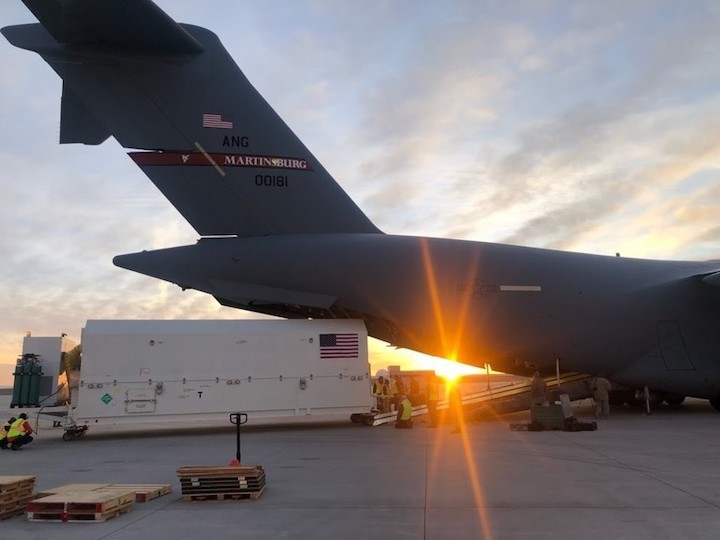
Quelle: SN
----
Update: 10.07.2019
.
Second GPS III satellite encapsulated for July 25 launch
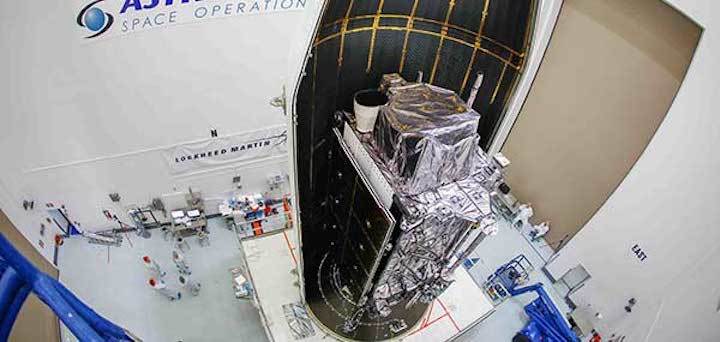
The second next-generation GPS III satellite — nicknamed “Magellan” by the U.S. Air Force — is encapsulated and ready for its planned July 25 launch.
On June 26, Lockheed Martin Space and United Launch Alliance (ULA) technicians completed encapsulating GPS III Space Vehicle 02 (GPS III SV02) in its launch fairings at the company’s Astrotech Space Operations facility, where the satellite has undergone pre-launch processing and fueling since its March 19 arrival in Florida. This final step enclosed GPS III SV02 in a protective, aerodynamic, nose-cone shell.
In the coming days, the enclosed GPS III SV02 satellite will be mounted to a ULA Delta IV rocket for launch. The current window for launch on July 25 opens at 10:55 a.m. ET.
“GPS III SV02 is launching just a brisk seven months after the nation’s first GPS III satellite lifted off back in December. The first satellite’s performance during on-orbit testing has exceeded expectations,” said Johnathon Caldwell, Lockheed Martin’s vice president for Navigation Systems. “We are excited to deploy more GPS III satellites so this new technology and capabilities can be distributed constellation-wide.”
GPS III satellite production and launch cadence is picking up. On May 27, the Air Force declared the next GPS III satellite, GPS III SV03, available for launch, pending an official launch date.
“More GPS III satellites are coming. If you looked at our production line back in Denver today you would see GPS III space vehicles 04, 05 and 06 already fully-assembled and in various stages of testing. And space vehicles 07 and 08 are being built up at the component assembly level now,” Caldwell added. “It is a smooth, efficient, methodical process.”
Lockheed Martin is under contract to develop and build up to 32 GPS III/IIIF satellites for the Air Force. GPS III will deliver three times better accuracy and provide up to eight times improved anti-jamming capabilities. GPS III’s new L1C civil signal will make it the first GPS satellite to be interoperable with other international global navigation satellite systems, like Galileo.
Additional GPS IIIF capabilities will begin being added with the 11th satellite. These will include a fully-digital navigation payload, a Regional Military Protection capability, an accuracy-enhancing laser retroreflector array, and a search-and-rescue payload.
Quelle: GPS WORLD
----
Update: 15.07.2019
.
Launch Fairings Up: Second Lockheed Martin-Built GPS III Satellite Ready For July 25 Liftoff

TITUSVILLE, Fla., The GPS satellite constellation is about to get its next heathy dose of new technology and more advanced capabilities. The second next-generation, Lockheed Martin (NYSE:LMT)-built GPS III satellite – nick-named "Magellan" by the U.S. Air Force -- is sealed up and ready for its planned July 25 launch.
On June 26, Lockheed Martin Space and United Launch Alliance (ULA) technicians completed encapsulating GPS III Space Vehicle 02 (GPS III SV02) in its launch fairings at the company's Astrotech Space Operations facility, where the satellite has undergone pre-launch processing and fueling since its March 19 arrival in Florida. This final step enclosed GPS III SV02 in a protective, aerodynamic, nose-cone shell.
In the coming days, the enclosed GPS III SV02 satellite will be mounted to a ULA Delta IV rocket for launch. The current window for launch on July 25 opens at 10:55 a.m. ET.
"GPS III SV02 is launching just a brisk seven months after the nation's first GPS III satellite lifted off back in December. The first satellite's performance during on-orbit testing has exceeded expectations," said Johnathon Caldwell, Lockheed Martin's vice president for Navigation Systems. "We are excited to deploy more GPS III satellites so this new technology and capabilities can be distributed constellation-wide."
GPS III satellite production and launch cadence is picking up. On May 27, the Air Force declared the next GPS III satellite, GPS III SV03, "Available for Launch," pending an official launch date.
"More GPS III satellites are coming. If you looked at our production line back in Denver today you would see GPS III space vehicles 04, 05 and 06 already fully-assembled and in various stages of testing. And space vehicles 07 and 08 are being built up at the component assembly level now," Caldwell added. "It is a smooth, efficient, methodical process."
Lockheed Martin is under contract to develop and build up to 32 GPS III/IIIF satellites for the Air Force. GPS III will deliver three times better accuracy and provide up to eight times improved anti-jamming capabilities. GPS III's new L1C civil signal will make it the first GPS satellite to be interoperable with other international global navigation satellite systems, like Galileo.
Additional GPS "IIIF" capabilities will begin being added at the 11th satellite. These will include a fully-digital navigation payload, a Regional Military Protection capability, an accuracy-enhancing laser retroreflector array, and a Search & Rescue payload.
Quelle: Lockheed Martin
----
Update: 18.07.2019
.
Launch of ULA's last 'single stick' Delta IV rocket from Cape Canaveral delayed
The planned late July liftoff of a United Launch Alliance Delta IV rocket from Cape Canaveral Air Force Station has been delayed about a month, the company said Wednesday.
Teams will now target no earlier than Aug. 22 for liftoff from Launch Complex 37 of the final "single stick" Delta IV with an Air Force Global Positioning System satellite.
ULA said the mission, known as GPS III SV02, was delayed "due to an anomaly during component testing at a supplier which has created a crossover concern." The same concern also was noted last week when the launch of an Atlas V rocket, also a ULA product, was delayed to no earlier than Aug. 8.
The company confirmed to FLORIDA TODAY that the same issue — tied to the upper stage — caused both delays.
ULA flies two variants of Delta IV. One is the standard rocket that has one core booster, while Delta IV Heavy flies with three cores. The latter will continue flying from Cape Canaveral and Vandenberg Air Force Base in California.
Next up on the Eastern Range, meanwhile, is SpaceX. The company will launch a Falcon 9 rocket with an uncrewed Dragon spacecraft packed with thousands of pounds of cargo and supplies for the International Space Station. Liftoff is targeted for 7:35 p.m. Sunday and the first stage will return to land at Cape Canaveral's Landing Zone 1.
Quelle: Florida Today
----
Update: 3.08.2019
.
GPS satellite installed atop Delta 4 launcher
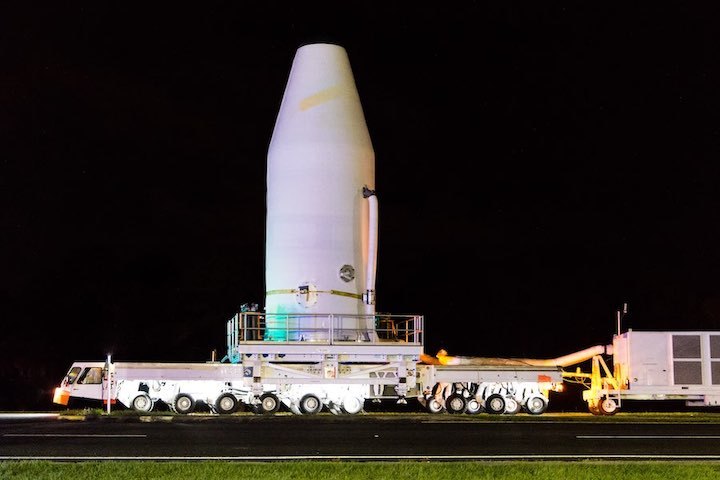
The U.S. Air Force’s next GPS navigation satellite met its ride into space this week with the spacecraft’s bolting on top of a United Launch Alliance Delta 4 rocket at Cape Canaveral in preparation for liftoff Aug. 22.
The spacecraft, built by Lockheed Martin, traveled from the Astrotech payload processing facility in Titusville, Florida, on an over-the-road transporter to Cape Canaveral’s Complex 37 launch pad. Teams there raised the satellite, already inside its payload shroud, on top of the Delta 4 rocket to begin the final steps of the integrated launch campaign.
Liftoff on Aug. 22 is scheduled for a 27-minute window that opens at 9 a.m. EDT (1300 GMT), four weeks later than previously planned.
ULA delayed the Delta 4 launch, along with the next flight of the company’s Atlas 5 launcher, to ensure the vehicles are free of a flaw that caused an unusual voltage measurement of an unspecified upper stage component during ground testing at the part’s supplier.
The Atlas 5 launch from Cape Canaveral is now scheduled for next Thursday, Aug. 8, with the Air Force’s fifth AEHF satellite to provide secure communication links for the military and government leaders.
The Atlas 5 mission next week will be ULA’s third launch of the year, followed two weeks later by the company’s fourth flight of 2019, when the Delta 4 takes off from Florida’s Space Coast.
The GPS 3 SV02 navigation satellite, nicknamed “Magellan,” arrived at the Florida spaceport in March for final launch preparations. The Air Force said the spacecraft passed final checkouts inside the Astrotech payload processing facility before encapsulation in late June.
The GPS network provides positioning and timing services worldwide for military and civilian users, beaming signals relied upon by airliners, ATMs, drivers and smart bombs, among numerous other users.
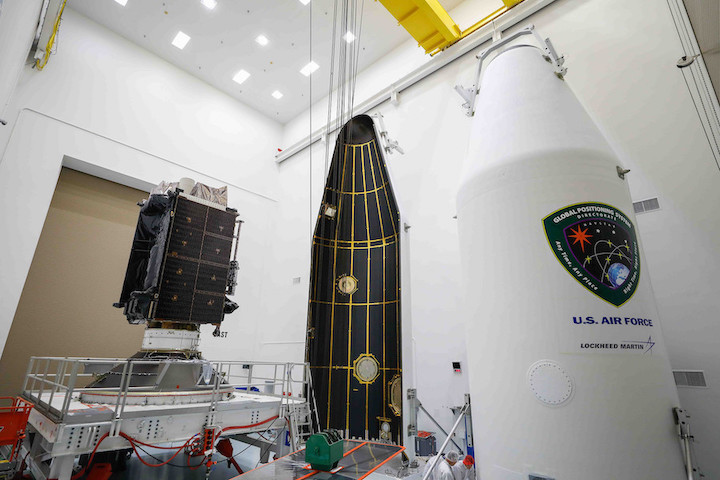
The Delta 4 launch Aug. 22 will be be the final flight of the Delta 4-Medium rocket variant, which flies with a single first stage booster, with additional thrust provided by strap-on solid rocket boosters. Two strap-on solid boosters are necessary to help get the GPS navigation satellite into its targeted orbit more than 12,000 miles (about 20,000 kilometers) above Earth.
The Delta 4-Heavy rocket configuration, made by combining three Delta 4 rocket cores together, will continue flying into the 2020s. The National Reconnaissance Office, using the Air Force as a contracting agent, has contracts in place for five more Delta 4-Heavy missions through 2024.
ULA decided in 2014 to retire the Delta 4-Medium configuration because it is more expensive than the company’s Atlas 5 rocket. The two rocket families are also largely redundant, but ULA kept the Atlas and Delta lines flying to ensure the Air Force had two rocket options to get military payloads into space.
There is no heavy-lift variant of the Atlas 5 rocket, so the Delta 4-Heavy will continue to fly into the 2020s, until ULA’s next-generation Vulcan launcher is operational.
The retirement of the Delta 4-Medium rocket also marks the last flight of the Delta 4’s 4-meter-diameter (13.1-foot) payload fairing. The Delta 4-Heavy rockets set for launch over the next five years all use a larger 5-meter (16.4-foot) payload shroud.
SpaceX’s Falcon 9 and Falcon Heavy rocket are now certified to fly the military’s national security satellites, providing the Air Force with a second family of launch vehicles alongside the Atlas 5 and Delta 4-Heavy.
The first of the new series of GPS 3 satellites, named “Vespucci,” launched in December aboard a Falcon 9 rocket.
Quelle: SN
----
Update: 15.08.2019
.
Second GPS III satellite tops rocket at launchpad
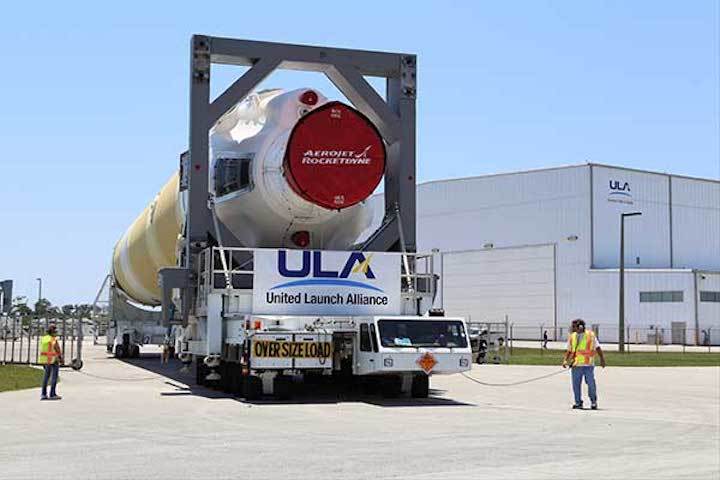
The second GPS III satellite — nicknamed Magellan — is now at the launchpad at Cape Canaveral Air Force Station, Florida, in preparation for liftoff on Aug. 22.
United Launch Alliance tweeted out an image of the encapsulated satellite on its way to the rocket.
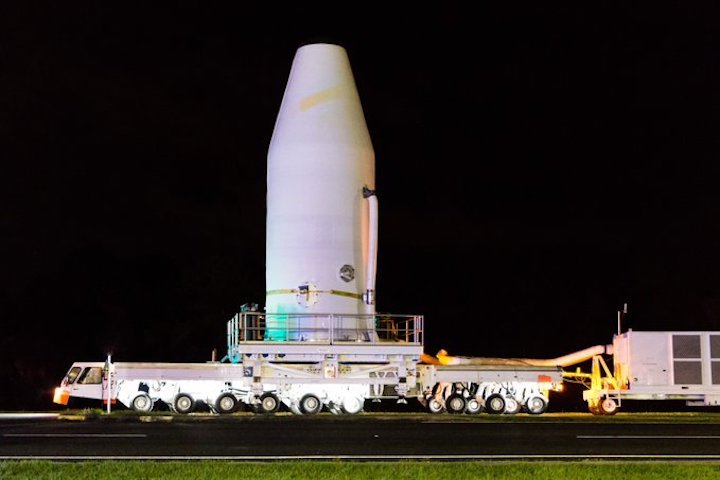
The next @AF_SMC Global Positioning System navigation satellite #GPSIIISV02 Magellan, built by @LockheedMartin, has moved to the launch pad and successfully hoisted atop its #DeltaIV rocket at Cape Canaveral Air Force Station for liftoff Aug. 22. ULA
The Lockheed Martin-built satellite was originally scheduled for launch on July 25, but the launch was pushed to Aig. 22 because of “an anomaly during component testing at a supplier that created a cross-over concern. Upon further evaluation, additional time is needed to replace and retest the component on the launch vehicle,” ULA said.
Launch Updates
The launch window on Aug. 22 will open at 9 a.m. EDT (1300 UTC) and extend to 9:27 a.m. EDT (1327 UTC),a duration of 27 minutes. ULA’s live countdown blog begins at 11:45 p.m. EDT (0345 UTC) on Aug. 21. The launch webcast starts at 8:40 a.m. EDT (1240 UTC).
Those interested can dial the ULA launch hotline at 1-877-852-4321 or join the conversation at www.facebook.com/ulalaunch, twitter.com/ulalaunch and instagram.com/ulalaunch; hashtags #DeltaIV #GPSIIISV02.
GPS III SV02 will be the 29th and final flight of the Delta IV Medium rocket, the 73rd GPS launch by a ULA or heritage vehicle and marks ULA’s 135th mission.
GPS III SV02 is named Magellan in honor of the Portuguese explorer who led the first expedition to circumnavigate the Earth.
The satellite, encapsulated in the 4-meter-diameter composite payload fairing, was moved overnight last week from its processing facility to the seaside launchpad at a top speed never exceeding 5 mph.
The satellite was hauled by a motorized KAMAG Elevating Platform Transporter (EPT) that provided hydraulic leveling and precision positioning capabilities along the route. The EPT also towed a Portable Environmental Control System (PECS) trailer to supply conditioned air to the payload fairing during the trip.
Once parked in the hoistway on the backside of the Mobile Service Tower (MST), technicians used the crane system in the gantry the next morning to carefully lift the satellite onto the Delta IV rocket’s second stage to complete a successful vertical integration of the launch vehicle and payload. The fully assembled rocket now stands 207 feet tall.
A tip-to-tail electrical test of the combined payload and launch vehicle will occur next, an operation known as the Integrated Systems Test (IST). Once that is completed, the comprehensive process to verify flight readiness will begin in parallel to final vehicle closeouts for the launch targeted for Aug. 22 at 9 a.m. EDT (1300 UTC).
ULA rockets have successfully launched 70 GPS satellites since 1978.
Quelle: GPS WORLD
----
Update: 20.08.2019
.
Weather OK for ULA's final Delta IV launch from Cape Canaveral
Any weather-related concerns leading up to the Thursday morning launch of a United Launch Alliance Delta IV rocket from Cape Canaveral are typical of summertime in Florida: the possibility of lingering cumulus clouds and accompanying showers.
Those translate to a 70% chance of favorable weather conditions at Launch Complex 37 leading up to the 9 a.m. liftoff, the Air Force's 45th Weather Squadron said Monday morning.
Teams will have 27 minutes to launch Delta IV — its final flight in the single core configuration — with a Global Positioning System spacecraft.
"Sufficient moisture and light steering flow should trigger isolated showers and storms over the Atlantic waters early Thursday morning," forecasters said.
"While light winds will keep most of this activity offshore, a shower approaching the coast and / or flight path cannot be ruled out, thus the primary concerns during the launch window are the cumulus cloud rule and flight through precipitation."
After its flight Thursday, Delta IV will enter the history books — only its three-core Delta IV Heavy sibling will fly into the 2020s. This launch's configuration, known as "medium" or "single-stick," will be retired to make room for Vulcan Centaur, ULA's future rocket slated to launch no earlier than 2021.
This GPS launch will be ULA's 135th mission overall and Delta IV's 29th in the single-stick configuration. The company's other offering, Atlas V, will also fly into the 2020s until it too is retired to make Vulcan the sole vehicle operating under ULA's umbrella.
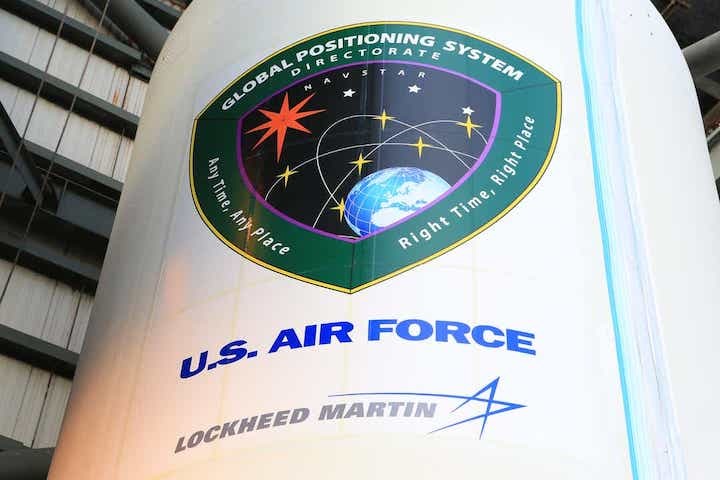
Launch Thursday
- Rocket: ULA Delta IV
- Mission: Air Force GPS satellite
- Launch Time: 9 a.m.
- Launch Window: Until 9:27 a.m.
- Launch Complex: 37 at Cape Canaveral Air Force Station
- Weather: 70% "go"
Join FloridaToday.com/Space at 7 a.m. Thursday for countdown chat and updates, including streaming of ULA's launch webcast.
Quelle: Florida Today
----
Update: 21.08.2019
.
ULA Set to Launch Last Single-Stick Delta IV Thursday with 'Magellan' GPS III Satellite
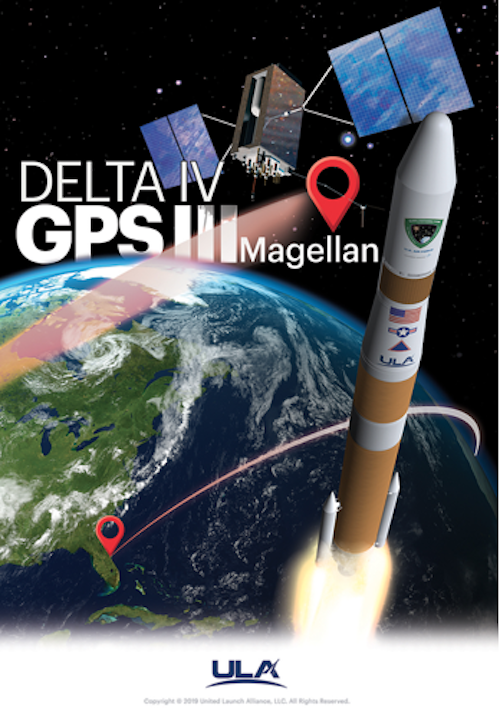
For the final time on Thursday, a “single-stick” Delta IV Medium booster will roar aloft from Space Launch Complex (SLC)-37B at Cape Canaveral Air Force Station, Fla., to transport a critical payload safely into orbit. It will be the 40th flight by a member of this venerable orange-and-white rocket family since November 2002 and the 15th outing in its “Medium+ (4,2)” configuration—characterized by a 13-foot-wide (4-meter) payload fairing and the presence of two solid-fueled Graphite Epoxy Motors (GEM)-60—and promises to put on quite a show for the Space Coast.
Launch is scheduled to occur during a 27-minute “window”, which opens at 9 a.m. EDT. Onboard the mighty Delta IV is the second Block III Global Positioning System (GPS) satellite, flying only a matter of months since SpaceX delivered GPS Block III-01 smoothly to orbit in October 2018.
By a strange quirk, Thursday’s last mission by a single-stick Delta IV will fly in exactly the same configuration as was utilized by the very first Delta IV, launched way back in November 2002 to deliver the Eutelsat W5 communications satellite to geostationary altitude. The Medium+ (4,2) flew another dozen times—carrying reconnaissance satellites, weather satellites and a half-dozen GPS Block II satellites—until its 14th and most recent mission in August 2016 which orbited the classified AFSPC-6 payload for Air Force Space Command.
When one looks at the numbers, the Medium+ (4,2) is by far the most-flown member of the Delta IV Medium fleet, although its siblings have carved their own impressive niches in space history. The Delta IV Medium, with no strap-on boosters, flew three times in its career, whilst the Medium+ (5,2) and Medium+ (5,4) logged 11 missions between them; the former retired in January 2018, the latter in March of this year.
“ULA made the decision to retire the Delta IV Medium launch vehicle when our National Security Space customer decided to compete missions in 2015,” said Tony Taliancich, ULA director and general manager of launch operations, in comments provided earlier this year to AmericaSpace. “Prior to the acquisition strategy change, ULA was required by the government to maintain two families of launch vehicles to meet assured access to space policy requirements. In a competitive environment, ULA must favor its lowest-cost product to meet the market requirements. Maintaining multiple product lines would lead to lower launch rates and higher costs.”
As detailed previously by AmericaSpace, the retirement of the single-stick Delta IV fleet leaves United Launch Alliance (ULA) with the gigantic Delta IV Heavy as the sole remaining member of its Delta fleet, together with the Atlas V rocket line and the Vulcan-Centaur heavylifter, which is waiting in the wings for a maiden voyage no sooner than June 2021.
“ULA expects that flying-out the Delta IV Medium and transitioning to Vulcan-Centaur will provide the lowest-cost, most reliable support for our launch customers,” added Mr. Taliancich. “ULA will continue flying the Delta IV Heavy launch vehicle as long as it is required by our customers. Once transitioned to Vulcan, we will be able to provide a single-stick Vulcan that can meet Delta IV Heavy mission requirements at a lower price.” Current planning envisages approximately one Heavy launch per annum, through 2024.
Primary payload for Thursday’s Delta IV Medium swansong is the second Block III GPS—alphanumerically designated “GPS III-02”—which is part of a next-generation constellation of global positioning, velocity and timing satellites, bound for Medium Earth Orbit (MEO). The Air Force awarded a $1.4 billion contract to Lockheed Martin back in May 2008 to develop Block III, which is anticipated to eventually comprise up to 32 satellites, launched through 2034. However, the program’s inaugural launch last October was five years later than originally planned, due to ongoing payload problems.
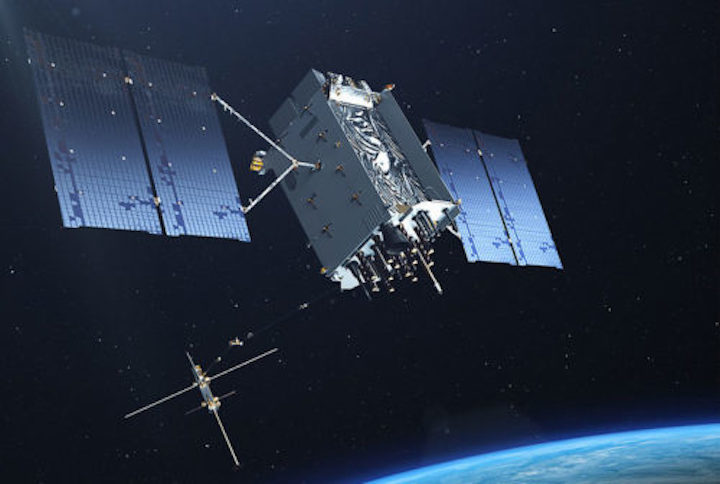
-
The Block III is the most capable Global Positioning System (GPS) network to date. Image Credit: Lockheed Martin
Following the May 2008 contract award, the GPS Block III program completed its Critical Design Review (CDR) phase in August 2010, which validated its design to ensure it would meet its advertised requirements, and a delta Preliminary Design Review (dPDR) in April 2013 addressed design modifications—including a search-and-rescue payload and Laser Retroreflector Array (LRA)—for later members of the Block III network.
By June 2017, the system module, propulsion core and antenna deck of GPS III-02 was structurally assembled and began an extensive series of environmental and acoustic tests, which was successfully concluded the following September. This involved pummeling the satellite with 140 decibels from high-powered horns, sufficient to shake anything loose which was not properly attached, and Thermal Vacuum (TVAC) testing was wrapped up later that fall. In August 2018, the Air Force declared the GPS III-02 was “Available for Launch” and on 18 March of this year the satellite was shipped aboard a C-17 Globemaster III heavylift aircraft from Buckley Air Force Base in Aurora, Colo., to Cape Canaveral for launch. On 26 June, GPS III-02 was encapsulated inside the 13-foot-wide (4-meter) payload fairing. The payload was moved to the SLC-37B pad surface and installed atop the Delta IV Medium+ (4,2) in the small hours of 2 August, ahead of a tip-to-tail Integrated Systems Test (IST) of the entire vehicle.
With 500 times the transmitting power of current GPS systems, Block III benefits from improved navigational warfare capabilities, with three times better accuracy and eight times better anti-jamming functionality. This enables the satellites to shut off GPS service to limited geographical locations, whilst maintaining uninterrupted provision for U.S. and allied forces. Block III features a cross-linked command and control architecture, which allows the entire constellation to be updated from a single ground station. Furthermore, the new satellites will showcase a new spot-beam capability for enhanced military (“M-Code”) coverage and increased resistance to hostil jamming. All told, these enhancements are expected to produce improved accuracy and assured availability for military and civilian users worldwide.
Based upon Lockheed Martin’s tried-and-true A2100 “bus”, whose modular framework can supply 15 kilowatts of electrical power via high-efficiency solar cells, radiation-cooled traveling-wave-tube assemblies and improved heat-pipe design, each GPS Block III weighs around 8,500 pounds (3,900 kg). The A2100’s 15-year operational life span represents a 25-percent leap over the GPS IIF satellites currently aloft.
Last December’s GPS III-01 was nicknamed “Vespucci”, in honor of the 15th-century Italian explorer, cartographer and navigator Amerigo Vespucci. In keeping with tradition, GPS III-02 will be named for Ferdinand Magellan, the Portuguese explorer who first circumnavigated the globe in the early 16th century. “As we prepare to launch this second GPS III satellite, we acknowledge a major transition of the GPS III program into a production program,” said Col. Steve Whitney, director of the GPS Directorate. “Having successfully launched our “Satellite of Firsts”, Vespucci, last December, we now look forward to a more regular pace of launches with this one and several more just on the horizon, as we continue to uphold the Gold Standard in space based position, navigation and timing.”
Looking ahead, GPS III-03 is slated to fly atop a SpaceX Upgraded Falcon 9, later this year. This third Block III satellite was completed in November 2017 and sailed smoothly through environmental and TVAC testing in June of last year.
Quelle: AS
----
Update: 22.08.2019
.
GPS III SV 2 ready to launch aboard Delta IV from CCAFS
CAPE CANAVERAL AIR FORCE STATION, Fla. --
The Air Force’s newest Global Positioning System (GPS) III satellite, Space Vehicle 02 (SV02) is ready for launch from Cape Canaveral Air Force Station's Space Launch Complex 37
The Lockheed Martin GPS III SV02 is set to launch Aug. 22 aboard an United Launch Alliance (ULA) Delta IV rocket. The launch window opens at 9 a.m. EDT and will remain open for 27 minutes. A live-feed will begin 20 minutes prior to the launch, concluding approximately 14 minutes after launch at the main engine cut off. A simulcast of the broadcast can be viewed at https://www.ulalaunch.com/missions.
The USAF Space and Missile Systems Center (SMC), home to the vanguard of satellite acquisition professionals, and the nation’s launch procurer of choice, was responsible for GPS III SV02’s rigorous Mission Assurance certifications and testing leading to full launch- and mission-readiness. SMC also conducted a rigorous source selection to ensure the ULA Delta IV rocket met all mission requirements, which included examining every single piece of hardware that built the rocket. This due diligence enables the satellite to be reliably placed on orbit to meet civilian and Warfighter communications needs.
“As we seek to modernize GPS, we bid farewell and thank you to a launch vehicle with an excellent track record in the Delta IV (4,2). We look forward to this final, successful launch for this ULA mainstay,” said Lt. Gen. John F. Thompson, Space and Missile Systems Center commander and Air Force program executive officer for Space. “The GPS program is a prime example of SMC 2.0 as we continue to modernize our fleet at EPIC Speed.”
GPS III SV02, also known as “Magellan,” in honor of Ferdinand Magellan, the Portuguese explorer who led the first expedition to circumnavigate the Earth, will be launched to augment the current GPS constellation comprised of 31 operational spacecraft. GPS satellites operate in Medium Earth Orbit at an altitude of approximately 20,200 km (12,550 miles) in six planes. Each satellite circles Earth twice per day.
GPS is the “Gold Standard” of positioning, navigation and timing services for more than four billion users worldwide. This latest generation of GPS satellite boasts a 15-year design life, 25 percent longer than the most recent GPS IIF satellites on orbit. It brings new capabilities to users such as a fourth civil signal, the new L1C civilian signal, which opens the window for future interoperability with international satellite navigation systems.
“Within the Production Corps we believe ‘Winning is an attitude.’ The road to this second launch is a prime example of how the team transforms belief into action,” said Col. Edward Byrne, Medium Earth Orbit (MEO) Spacecraft Production Division chief. “Through this extremely collaborative effort, we’re on the verge of launching our second satellite in just seven months, with a third launch on the horizon. We continue to strive towards our goal of maintaining the ‘Gold Standard’ of PNT.”
GPS III satellite signals are more accurate and more powerful than in previous generations, providing improved performance for civilian and military users. Magellan will add another M-Code-capable satellite as the team continues to modernize the GPS fleet. M-Code will provide more accurate military signals with improved anti-jamming capabilities for the Warfighter. Full M-Code capability is set to roll out with OCX (the GPS ground segment) Block 2.
“We are in final preparations to launch Magellan thanks to an amazing amount of hard work and dedication from the entire government and industry team,” said Col. Robert Bongiovi, Launch Enterprise director. This final voyage for the Delta IV Medium launch vehicle will be a momentous occasion capping a legacy of success that started 17 years ago.”
SMC’s Production Corps, located at Los Angeles Air Force Base in El Segundo, California, leads the Magellan team. SMC’s Launch Enterprise leads the launch, which will be on ULA’s Delta IV (4,2) rocket at Cape Canaveral Air Force Station. Lockheed Martin Space Systems Corporation is the prime satellite contractor. Air Force Space Command’s 50th Space Wing and 2nd Space Operations Squadron operate the GPS constellation.
Next Launch GPS III - SV02 on a Delta IV rocket from Cape Canaveral AFB, FL
scheduled for:
22 Aug 19 at 13:00 GMT
22 Aug 19 at 9:00am Eastern
Quelle: USAF
+++
Update: 17.45 MESZ
.
Start von Delta IV mit GPS III Space Vehicle 02 “Magellan”
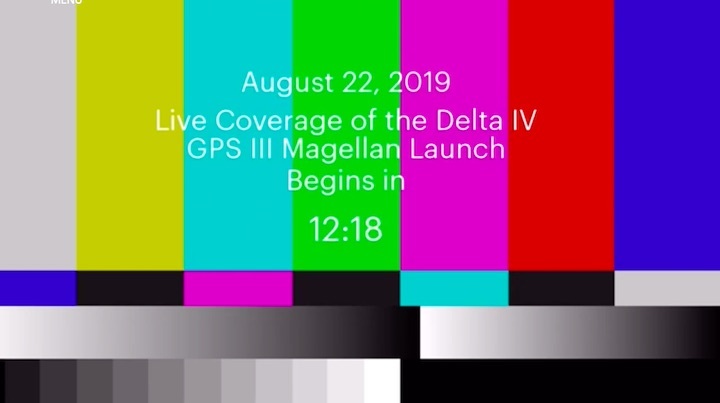

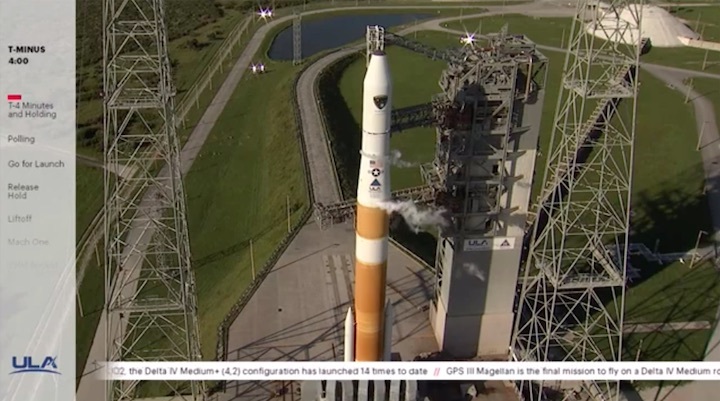
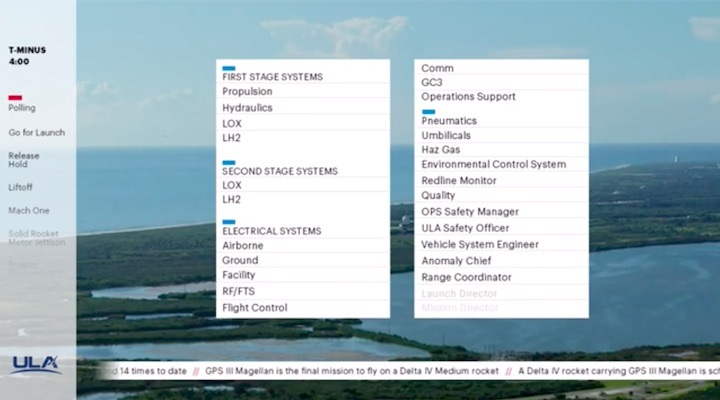

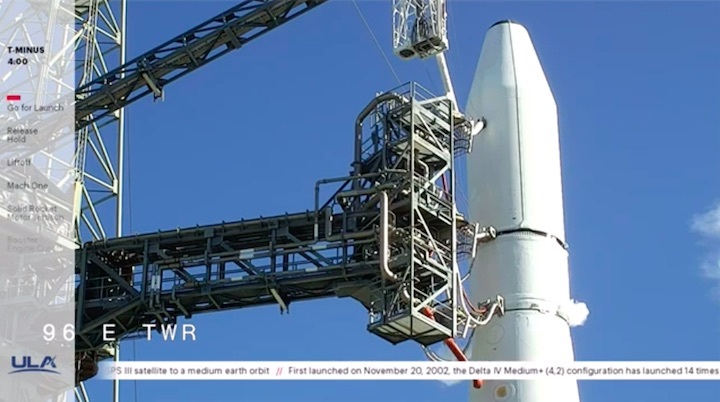
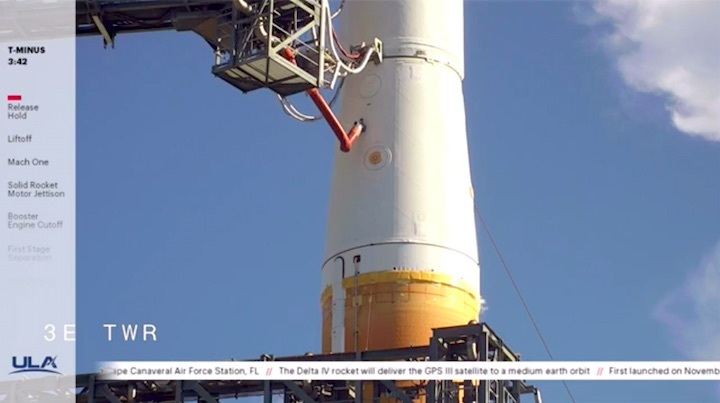
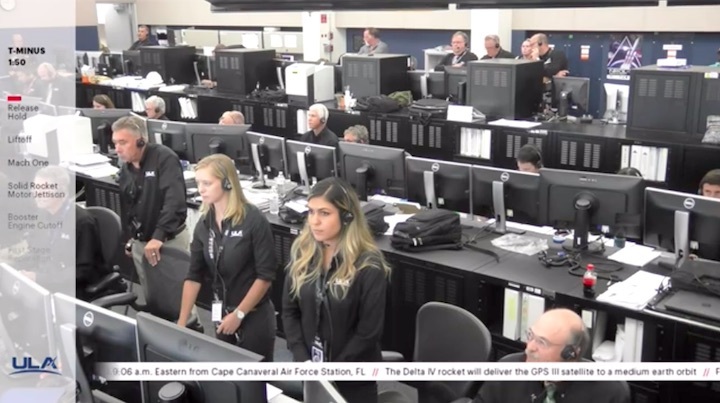

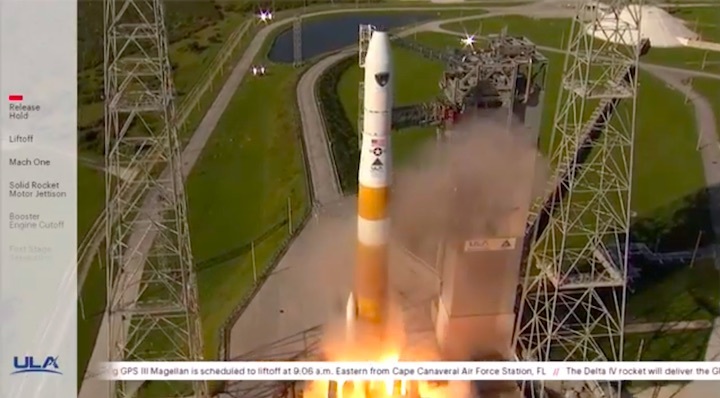
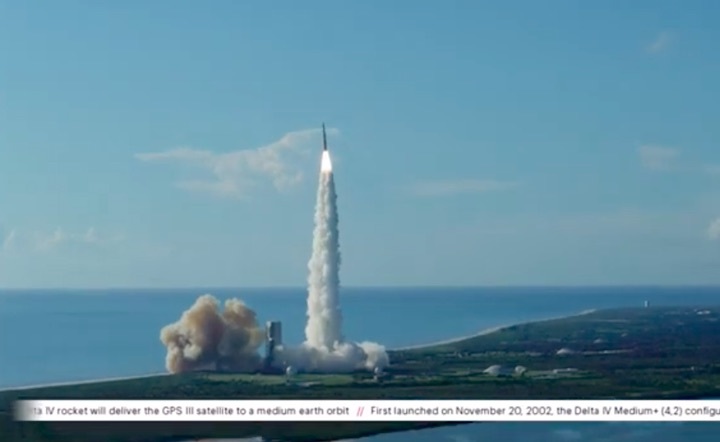
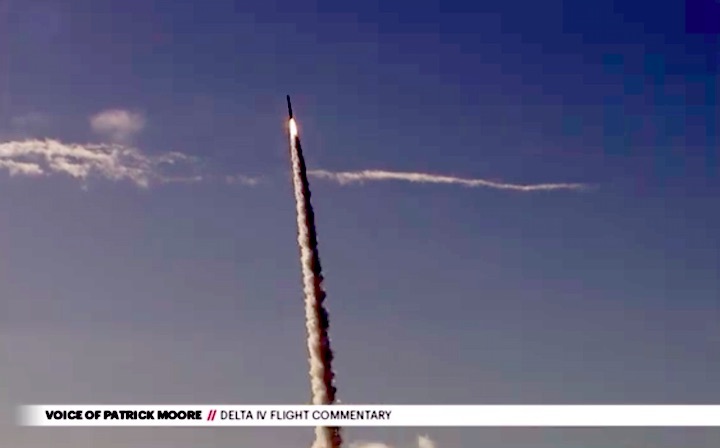
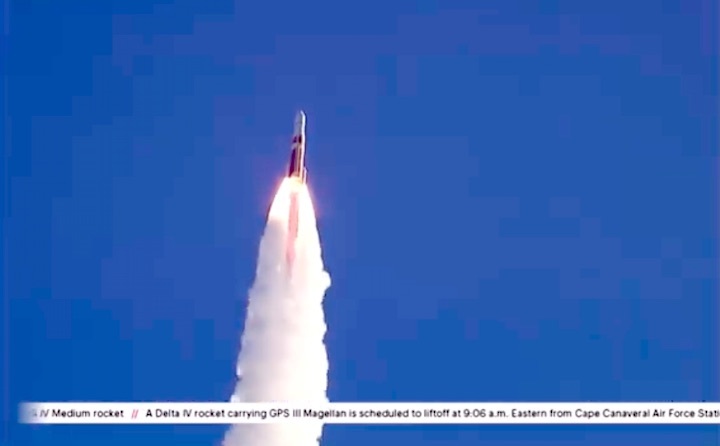
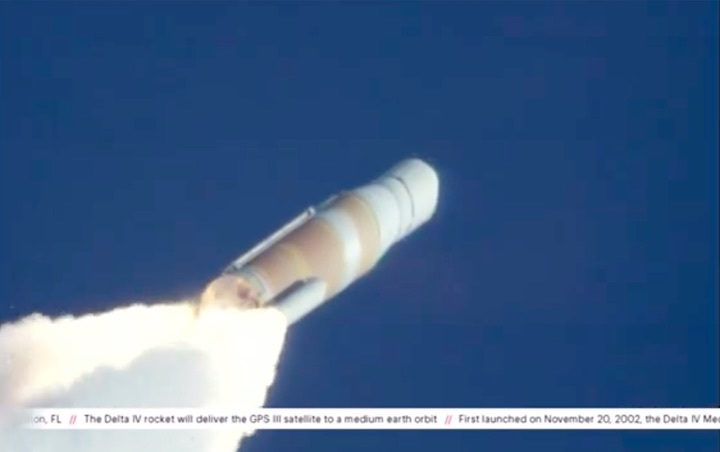

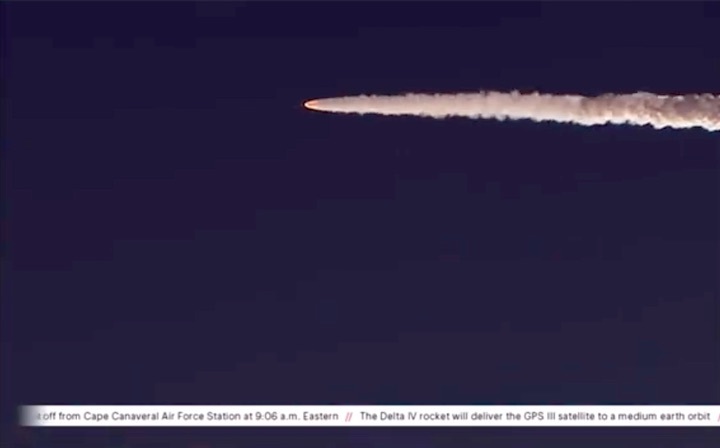
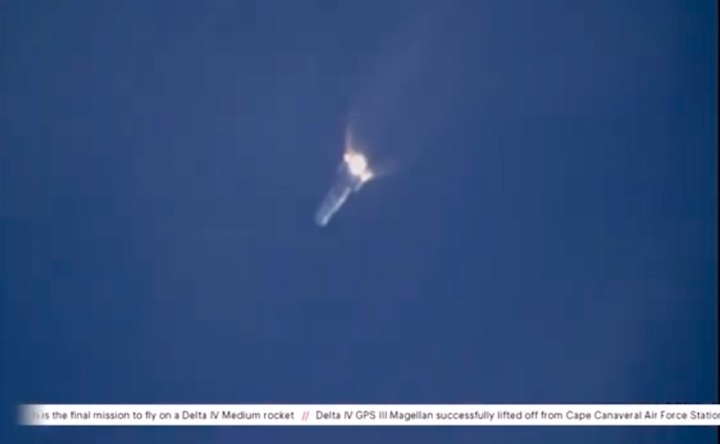
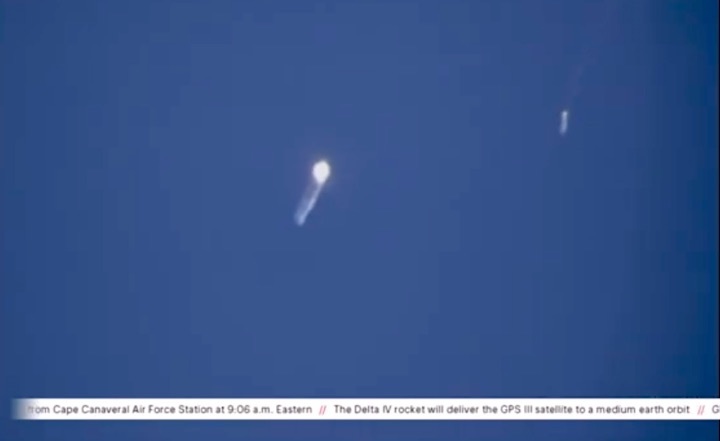
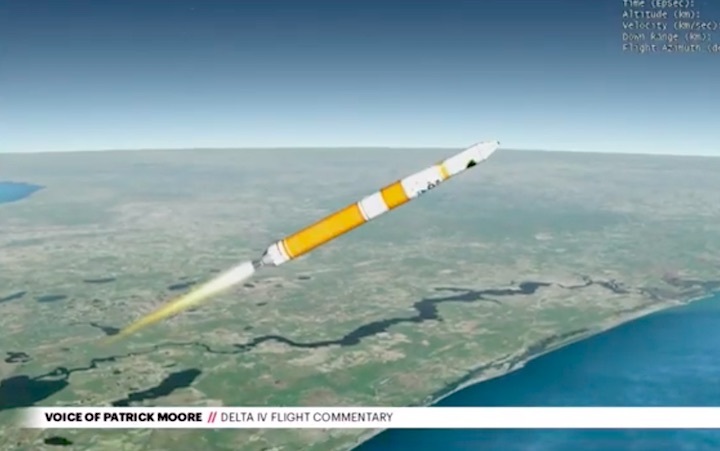
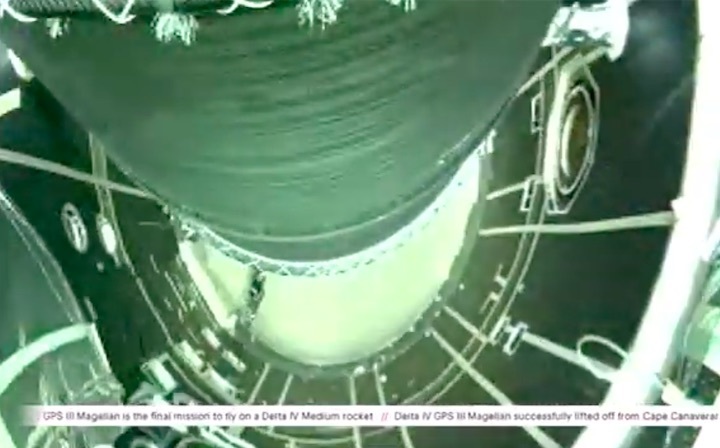

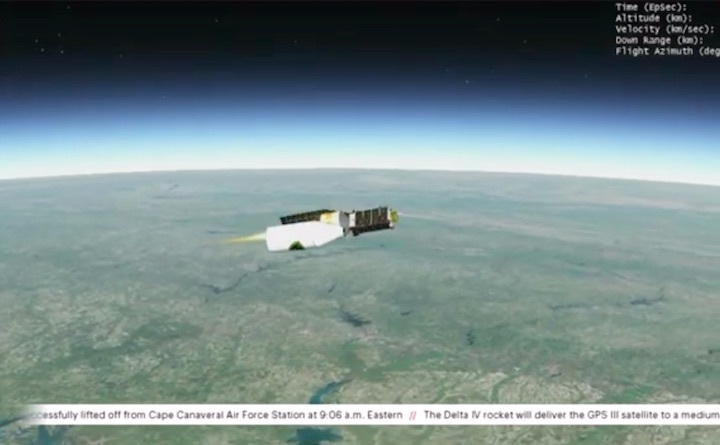
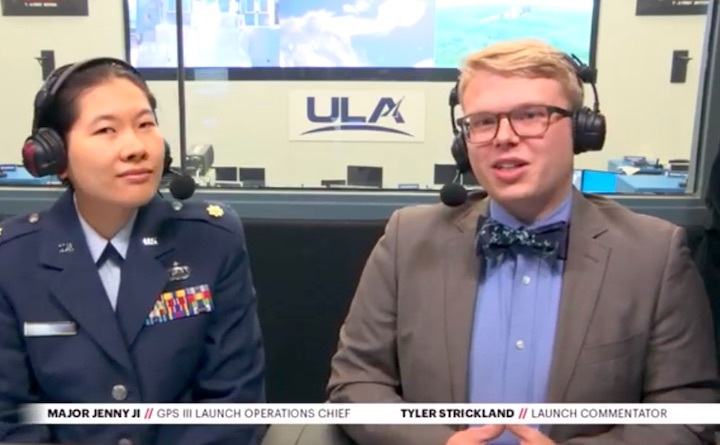
Quelle: ULA


